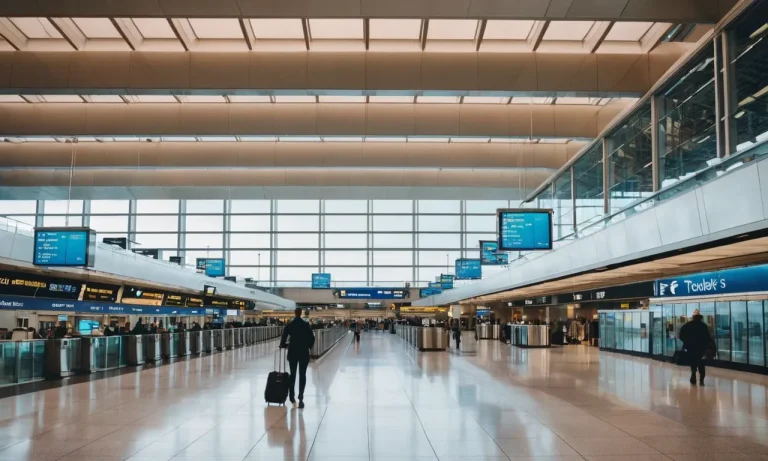How Rare Is It For A Plane To Crash?
Traveling by plane is one of the safest ways to travel. However, tragic plane crashes covered in the news can make some nervous flyers question just how safe commercial air travel really is.
If you’re short on time, here’s a quick answer to your question: plane crashes are extremely rare events. On average, there are fewer than 20 fatal crashes involving commercial passenger planes worldwide each year.
In this nearly 3,000 word article, we’ll take an in-depth look at plane crash statistics and explain why crashes don’t happen more often given the volume of flights every day. We’ll also explore some of the most common causes of plane crashes and highlight how the airline industry continues to find new ways to maximize flight safety through technology innovations and training protocols.
How Many Plane Crashes Happen Per Year on Average?
When it comes to plane crashes, it is natural to wonder just how often they occur. However, it’s important to note that plane crashes are actually quite rare events. The aviation industry has made significant advancements in safety measures, making air travel one of the safest modes of transportation.
Commercial Passenger Planes
Commercial passenger planes, which are the ones we typically think of when we talk about air travel, have an impressive safety record. According to the International Air Transport Association (IATA), the global airline accident rate in 2019 was 1.13 accidents per million flights.
This means that for every million flights operated by commercial airlines, there was an average of 1.13 accidents. It’s important to note that not all accidents involve fatalities, and the vast majority of accidents result in no or minimal injuries.
It’s worth mentioning that the number of accidents has been decreasing steadily over the years, thanks to advancements in technology and stricter safety regulations. Airlines invest heavily in training their pilots, maintaining their aircraft, and implementing safety protocols to ensure the well-being of their passengers.
Small Private Planes and Chartered Flights
Small private planes and chartered flights, on the other hand, have a slightly higher accident rate compared to commercial passenger planes. According to the National Transportation Safety Board (NTSB), in 2019, there were a total of 1,315 accidents involving general aviation aircraft in the United States alone.
However, it’s important to note that not all of these accidents were fatal, and many of them resulted in minor injuries or no injuries at all.
It’s worth mentioning that the accident rate for small private planes and chartered flights is influenced by various factors, including pilot experience, aircraft maintenance, and weather conditions. It’s crucial for individuals who operate or fly in these types of aircraft to prioritize safety and adhere to all necessary precautions.
What Are the Odds of Being in a Plane Crash?
When it comes to air travel, safety is often a top concern for many people. Understandably, the idea of being in a plane crash can be anxiety-inducing. However, it’s important to put things into perspective and understand the actual odds of such an event occurring.
Statistical Data
According to the Aviation Safety Network, the chances of being involved in a plane crash are extremely low. In fact, the odds are about 1 in 11 million. To put this into context, you are more likely to be struck by lightning (1 in 700,000) or win the lottery (1 in 302 million) than being in a plane crash.
Furthermore, the International Civil Aviation Organization (ICAO) reports that the global accident rate for commercial airlines has been steadily decreasing over the years. This is a result of advancements in technology, improved safety regulations, and rigorous training programs for pilots and airline personnel.
Factors that Contribute to Safety
There are several factors that contribute to the safety of air travel. First and foremost, aircraft are subject to strict maintenance procedures and regular inspections to ensure they are in optimal condition.
Additionally, pilots undergo rigorous training and are required to meet strict qualifications and hours of flight experience before they can operate commercial flights.
Another crucial aspect of aviation safety is air traffic control. Air traffic controllers play a vital role in ensuring safe takeoffs, landings, and navigating through busy airspace. They use sophisticated radar systems and communication protocols to coordinate the movement of aircraft and minimize the risk of collisions.
What Are the Leading Causes of Fatal Plane Crashes?
Pilot Error and Miscommunication
One of the leading causes of fatal plane crashes is pilot error and miscommunication. Pilots are highly trained professionals, but they are still susceptible to making mistakes. Whether it’s a lapse in judgment, poor decision-making, or a lack of proper communication between pilots and air traffic controllers, these errors can have catastrophic consequences.
According to a study conducted by the National Transportation Safety Board (NTSB), pilot error was found to be the primary cause of approximately 50% of all fatal plane crashes in the United States.
Mechanical Failures and Malfunctions
Another significant cause of fatal plane crashes is mechanical failures and malfunctions. While modern aircraft are equipped with advanced technology and undergo rigorous maintenance checks, mechanical failures can still occur.
These failures can range from engine malfunctions to faulty equipment, such as landing gear or navigation systems. According to a report by the Federal Aviation Administration (FAA), mechanical failures were responsible for approximately 20% of fatal plane crashes in the past decade.
It is worth noting that the aviation industry continuously works to improve safety measures and reduce the occurrence of mechanical failures.
Extreme Weather Conditions
Extreme weather conditions pose a significant risk to aviation safety and can contribute to fatal plane crashes. Severe thunderstorms, hurricanes, or heavy snowstorms can create hazardous flying conditions, making it difficult for pilots to navigate safely.
Strong winds, turbulence, and reduced visibility can all increase the chances of an accident occurring. The National Oceanic and Atmospheric Administration (NOAA) provides up-to-date weather forecasts and warnings to help pilots make informed decisions and avoid flying in dangerous conditions.
However, despite these precautions, extreme weather remains a factor in a small percentage of fatal plane crashes.
How Do Airlines and Manufacturers Improve Safety?
Ensuring the safety of passengers and crew is the top priority for airlines and aircraft manufacturers. They continuously work on improving safety through various measures.
Better Technology and Early Warning Systems
Airlines and manufacturers invest heavily in research and development to create better technology and early warning systems. These advancements help in detecting potential issues before they become major problems.
For example, the introduction of advanced weather radar systems allows pilots to navigate through severe weather conditions more effectively. Additionally, the development of sophisticated engine monitoring systems enables real-time monitoring of engine performance, helping detect any abnormalities and preventing potential failures.
Furthermore, the implementation of advanced collision avoidance systems, such as Traffic Alert and Collision Avoidance System (TCAS), plays a crucial role in preventing mid-air collisions. These systems constantly monitor the airspace around the aircraft and provide pilots with timely alerts and guidance to avoid potential conflicts with other aircraft.
More Extensive Training Requirements
The aviation industry has stringent training requirements for pilots, cabin crew, and maintenance personnel. This ensures that they are well-prepared to handle various situations and emergencies. Pilots undergo rigorous training programs that include simulator sessions, emergency procedures, and recurrent training to keep their skills up to date.
Cabin crew members also receive comprehensive training on emergency procedures, first aid, and customer service. This equips them with the necessary knowledge and skills to handle any potential issues or emergencies that may arise during a flight.
Similarly, maintenance personnel are required to undergo extensive training to ensure they are proficient in maintaining and repairing aircraft components and systems. Regular training and certification programs help them stay updated with the latest technology and industry standards.
Industry Safety Regulations and Oversight
The aviation industry is heavily regulated, with strict safety standards enforced by regulatory bodies such as the Federal Aviation Administration (FAA) in the United States and the European Union Aviation Safety Agency (EASA) in Europe.
These organizations set guidelines and regulations that airlines and manufacturers must adhere to.
Regular inspections and audits are conducted to ensure compliance with these regulations. Additionally, manufacturers undergo thorough certification processes to ensure their aircraft meet the required safety standards before they are allowed to enter service.
The collaboration between airlines, manufacturers, and regulatory bodies is vital in continuously improving safety in the aviation industry. By sharing information, conducting investigations, and implementing necessary changes, they strive to prevent accidents and enhance the overall safety of air travel.
Tips for Nervous Flyers and FAQs
Facts to Reassure Anxious Travelers
For nervous flyers, it can be comforting to know that plane crashes are extremely rare. In fact, statistically speaking, flying is one of the safest modes of transportation. According to the Aviation Safety Network, the global aviation accident rate in 2019 was just 0.18 accidents per million flights.
This means that the chances of being involved in a plane crash are incredibly low.
Furthermore, commercial airlines are subject to strict regulations and safety measures. They invest heavily in pilot training, aircraft maintenance, and safety technologies to ensure the highest level of safety for their passengers.
These safety measures, along with the expertise of pilots and air traffic controllers, contribute to the overall safety of air travel.
What to Keep in Mind About Plane Crashes in the News
It’s important to keep in mind that when plane crashes do occur, they often receive significant media attention. This can create a perception that flying is more dangerous than it actually is. However, it’s essential to remember that these incidents are outliers and not representative of the overall safety of air travel.
When interpreting news about plane crashes, it’s important to consider the context and the statistical rarity of such events. While any loss of life is tragic, it’s crucial to maintain a balanced perspective and rely on factual information rather than sensationalized headlines.
Questions Frequently Asked About Flying Safety
- What are the main causes of plane crashes? The main causes of plane crashes are pilot error, mechanical failures, and adverse weather conditions. However, it’s important to note that these incidents are rare and that the aviation industry continually works to improve safety measures.
- Is turbulence dangerous? Turbulence is a common occurrence during flights and is generally not dangerous. Modern aircraft are designed to withstand turbulence, and pilots receive training to navigate through it safely.
Remember to keep your seatbelt fastened at all times, as turbulence can occur unexpectedly.
- Are smaller planes less safe than larger commercial aircraft? While smaller planes may carry a different set of risks, they are subject to the same safety regulations as larger commercial aircraft. The safety of any flight ultimately depends on factors such as pilot training, maintenance, and adherence to safety protocols.
- What can I do to reduce anxiety while flying? There are several strategies you can try to reduce anxiety while flying. These include deep breathing exercises, listening to calming music, distracting yourself with a book or movie, or seeking professional help if your anxiety is severe.
It can also be helpful to educate yourself about the safety measures in place and the statistics that demonstrate the safety of air travel.
For more information and resources on flying safety, you can visit websites such as the Federal Aviation Administration (FAA) at www.faa.gov or the International Civil Aviation Organization (ICAO) at www.icao.int.
These authoritative sources provide valuable information and insights into aviation safety.
Conclusion
While plane crashes are visually horrific and often get extensive media coverage, the facts clearly show that fatal commercial airline crashes are extremely rare events nowadays.
Flying continues to be one of the safest forms of transportation thanks to rigorous safety protocols across the aviation industry. Hopefully looking at the actual data can help put nervous travelers’ minds at ease.








